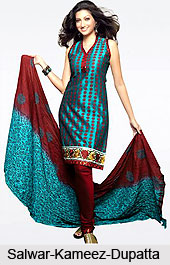 Salwar-Kameez-Dupatta is a popular dress among the Indian women. It originated in regions of Central Asia, dominated by Turkish and Iranian people. Among them, the habit of putting in baggy trousers existed, drawn tight with strings, a pattern, absolutely similar to today`s salwar. Indeed, the salwar is a kind of loose trousers, narrowing down a bit towards the bottom, contrasted to the upper wide gather. However, instead of strings, sometimes, the salwar is held firmly by elastic belt. The kameez, is on the other hand, a, long shirt or tunic-like dress. Besides, the upper-garment of kameez is accompanied by a dupatta. There are various patterns or styles of using it. A dupatta is a cloth-piece, draped around the head, and the front upper portion of the body, by some, while others may pass the dupatta, over the shoulders only, to enhance the look. Therefore, salwar-kameez, resembling a male Pathan suit, alone makes for a men`s dress, but a salwar-kameez when taken with a dupatta, it turns out to be the suitable dress for everybody, who feels comfortable in it.
Salwar-Kameez-Dupatta is a popular dress among the Indian women. It originated in regions of Central Asia, dominated by Turkish and Iranian people. Among them, the habit of putting in baggy trousers existed, drawn tight with strings, a pattern, absolutely similar to today`s salwar. Indeed, the salwar is a kind of loose trousers, narrowing down a bit towards the bottom, contrasted to the upper wide gather. However, instead of strings, sometimes, the salwar is held firmly by elastic belt. The kameez, is on the other hand, a, long shirt or tunic-like dress. Besides, the upper-garment of kameez is accompanied by a dupatta. There are various patterns or styles of using it. A dupatta is a cloth-piece, draped around the head, and the front upper portion of the body, by some, while others may pass the dupatta, over the shoulders only, to enhance the look. Therefore, salwar-kameez, resembling a male Pathan suit, alone makes for a men`s dress, but a salwar-kameez when taken with a dupatta, it turns out to be the suitable dress for everybody, who feels comfortable in it.
History recounts that, the court-nobles of the Ottoman and Qajar dynasty, upheld salwar-kameez as their court-costume. This royal background made this particular costume reach the heights of fame. Indeed, this specific style of dress was imported in India, by the Muslim invasion that set off in the 12th century. The Turko-Iranian regime of the Delhi Sultanate, and later the Mughal Empire in India, sustained the tradition of dressing in Salwar-Kameez in India.
Variations in Salwar-Kameez-Dupatta
Salwar-Kameez-Dupatta, has received the maximum embrace in northern India. It is considered as a traditional costume for women, given their comfort-friendly factor. In the present times, experimentation and innovations, at par with tradition, are on the rise, with regard to the designing of salwar-kameez-dupatta, almost in the entire country. The very first variety could be in the base material used for the costume. It could of plain cotton, rich silk, tussar, crepe, georgette, shiffon, khadi, or the other types of fabric available. The next variation occurs in the flare and the pleats, making up the salwar. Colours also have an expanding range, starting from the bright shades like maroon, red, violet, blue, yellow, black, to the lighter shades of white, sky, pink, and more. This colour-spectrum is applicable for the entire set. Another, feature of variation, regarding the kameez is the cut of the neckline-pattern and the sleeves. It can have full-sleeves, or short-sleeves or no-sleeves.
Designs of Salwar-Kameez-Dupatta
The several designs, of the Salwar-Kameez-Dupatta, include sequin-embroidery or semi-precious stone embroidery, mirror-work, artwork, cut-work, or simple but sophisticated prints, hand-paintings, etc. The high point of designer`s excellence is the intricate Zardozi and the Zari embroidery, made on the exclusive pieces. Zardozi, is a Persian embroidery done with gold or silver threads, called Zari in India, or copper wire, gilded with gold, along with kundan, or stone-embellishments. It is obvious from the fact, that with such awesome, multifarious shapes and shades, salwar-kameez-dupatta has become really popular in the country. It is primarily, one of the most used costumes of women in India. A woman can easily flaunt herself in a simple but elegant salwar-kameez-dupatta in office, while in a wedding party she can beautify herself with a Zardozi version and her style options are many.





















